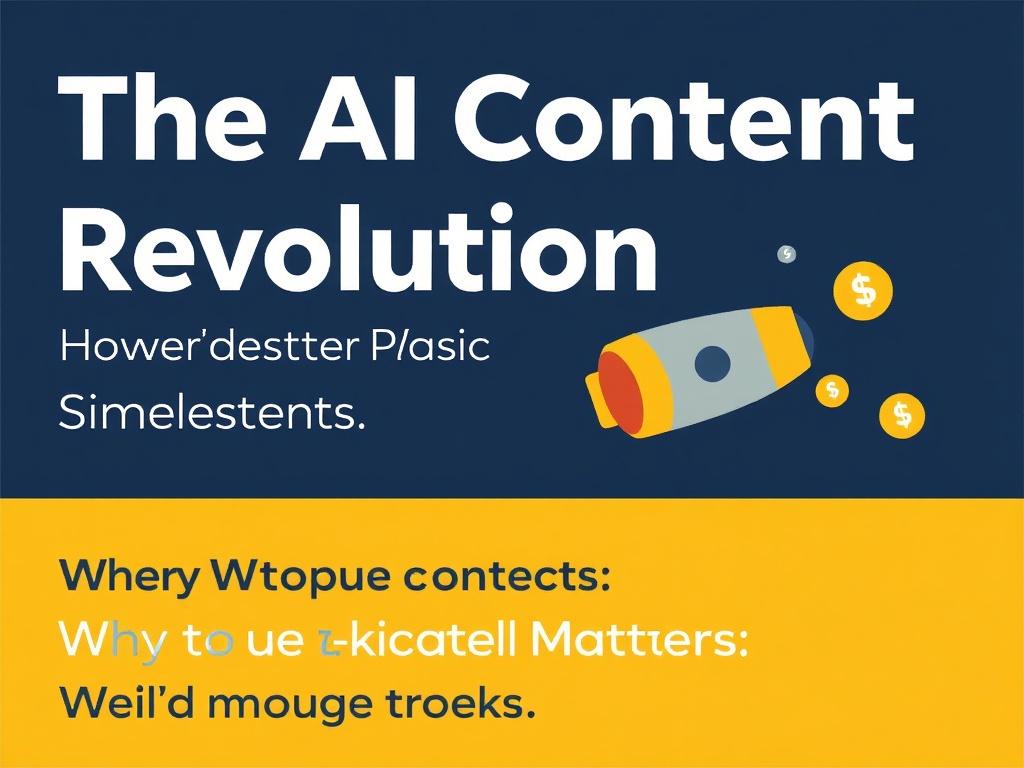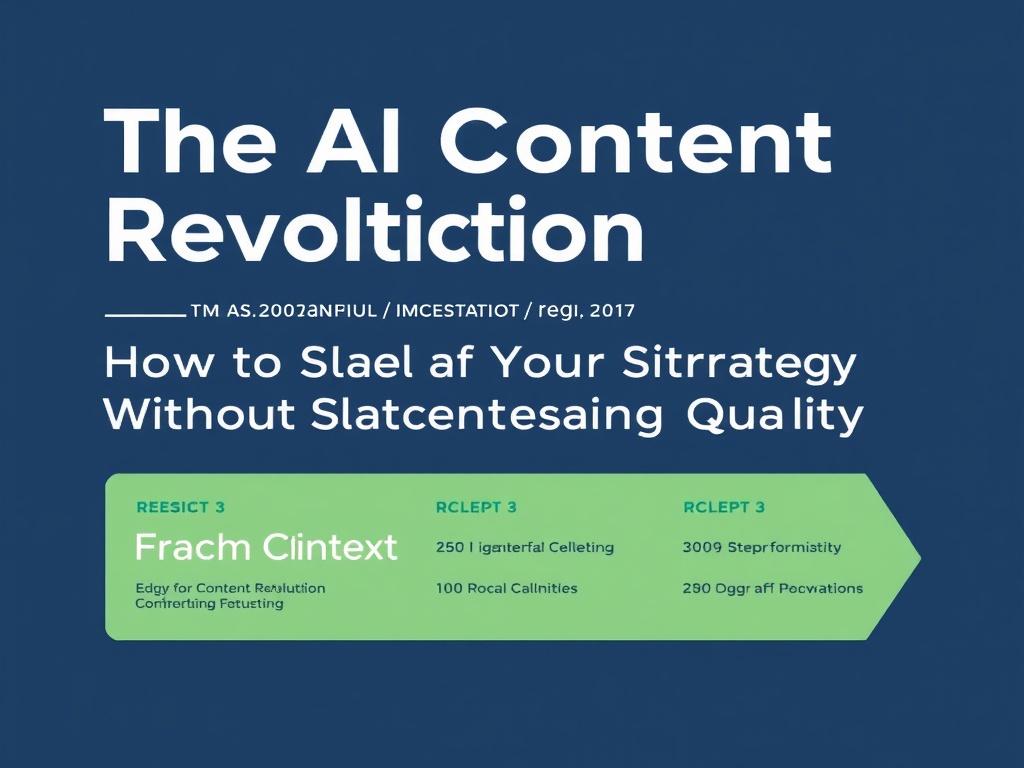Artificial intelligence has changed the rules of the content game. What used to take entire teams weeks to research, draft, and polish can now be started in minutes with the help of models that generate outlines, draft paragraphs, create headlines, and even suggest images or video scripts. That speed is thrilling — and a little terrifying. The real question isn’t whether AI can generate content at scale; it’s whether you can scale without sacrificing the clarity, credibility, and usefulness that make content valuable in the first place. In this article I’ll walk you through the practical steps to build a content operation that uses AI to amplify human expertise, not replace it. You’ll get frameworks, checklists, tool recommendations, and a practical roadmap to move from experimentation to a repeatable, quality-first content machine.
Why the AI Content Revolution Matters

AI-generated content is not just cheaper or faster — it forces a rethink of how teams operate. Traditionally, content creation has been linear: brief, draft, revise, finalize, publish. AI flips that pattern into an iterative, parallel process where ideation and drafting can happen simultaneously across many topics, formats, and channels. That means you can test dozens of hypotheses quickly and find what resonates. But speed has a cost: inconsistency, factual errors, tone drift, and stale ideas if you lean too heavily on default outputs. The goal is to harness AI’s throughput while preserving the editorial judgment, domain expertise, and empathy that readers trust.
The promise and the pitfalls
AI brings undeniable benefits: scale, speed, personalization, and the ability to analyze huge amounts of data for content insights. But without governance, teams risk publishing content that is inaccurate, off-brand, or duplicated in ways that harm SEO. There’s also a reputational risk when AI outputs hallucinate facts or make claims that fall outside legal or ethical boundaries. The sweet spot is a system that combines model capabilities, human oversight, clear guidelines, and measurement.
Define Quality Before You Scale
Scaling responsibly starts with a clear definition of what “quality” means for your organization. Quality can include accuracy, readability, originality, usefulness, brand voice, SEO value, and legal compliance. Without these guardrails, “scale” turns into volume for volume’s sake.
- Start with a quality rubric: define the non-negotiables for every piece of content — factual accuracy, source citations, tone, and CTA clarity.
- Prioritize content types: not every asset needs the same level of review. Decide which pages or pieces require top-level scrutiny (e.g., product pages, legal content) and which can be more experimental (e.g., social posts, short-form blogs).
- Map audience expectations: understand what your readers expect from different formats and channels. A deeply-researched guide needs a different quality bar than a quick weekly roundup.
Build a quality rubric example
| Dimension | What to Check | Pass/Fail Criteria |
|---|---|---|
| Accuracy | All factual claims have credible sources; numbers checked | Sources cited or internal expert verified |
| Voice & Tone | Content matches brand voice and audience expectations | Tone score within allowable variance |
| SEO | Keyword intent matched; headings and meta optimized | Meets baseline on-target keyword density and structure |
| Originality | No evidence of plagiarism; unique insights added | Passes plagiarism check and adds 1+ original insight |
| Readability | Appropriate sentence length, structure, and clarity | Readability score within target range |
Choose Your AI Approach: Assist, Co-Create, or Autopilot
Not all AI strategies are equal. Choose a model of collaboration that matches your risk tolerance and resources.
Assist (Human-led)
In this model, AI is an assistant. Writers use AI to brainstorm headlines, suggest outlines, or generate draft paragraphs they then heavily edit. This keeps human judgment central and lets teams maintain control of quality. It’s ideal for high-stakes content and teams building internal skill.
Co-Create (Hybrid)
Co-create means AI generates a first draft or several variations and editors refine and fact-check the output. This model balances speed and quality, and is suited for medium-stakes content where volume matters but errors have consequences.
Autopilot (Model-led)
Autopilot is when AI produces content with minimal human oversight. It can work for low-risk channels (like internal knowledge base stubs or social captions) but should be applied sparingly and with guardrails, because the chance of errors and off-brand messaging increases.
Build the Right Team and Workflows
Scaling content requires process as much as technology. Clear roles, responsibilities, and handoffs prevent bottlenecks.
Key roles to define
- Content Strategist — sets the editorial calendar and alignment with business goals.
- AI Prompt Engineer — crafts prompts, templates, and controls model behavior.
- Subject-Matter Expert (SME) — verifies technical accuracy and adds insights.
- Editor — ensures voice, readability, and compliance with style guide.
- SEO Specialist — optimizes content discoverability and measures performance.
- Content Operations Lead — manages tools, workflow automation, and quality pipelines.
Process flow example
- Ideation: content strategist and SEO identify topics and KPIs.
- Prompting: prompt engineer generates initial drafts using templates tuned for tone and format.
- Draft Review: editor reviews and applies edits; SME verifies factual accuracy if needed.
- SEO Optimization: SEO specialist refines headings, meta tags, and internal links.
- Final QA: content operations runs checks (plagiarism, compliance, links).
- Publish & Monitor: content goes live and performance is tracked for iteration.
Prompts, Templates, and Content Frames: The Engines of Scale
Well-designed prompts and templates let you scale without randomness. They capture institutional knowledge and consistently communicate expectations to the model.
Designing effective prompts
A good prompt is explicit, structured, and includes examples. Treat prompts like micro-briefs. Include: target audience, desired tone, key points to cover, constraints (word count, no claims without sources), and the format (list, explainer, step-by-step guide). Version prompts and store them in a shared “prompt library” so teams can iterate and reuse.
Templates and content frames
Templates standardize structure. For instance, a long-form guide template might include an intro problem statement, 3–5 actionable sections, case study, FAQ, and conclusion with a CTA. Content frames keep quality consistent across hundreds of pieces and simplify review by making expectations explicit.
| Template Type | Best Use | Core Sections |
|---|---|---|
| How-to Guide | Product walkthroughs, educational content | Intro, Problem, Step-by-step, Examples, FAQ, CTA |
| Listicle | Quick reads, social sharing | Intro, Top N items with short descriptions, Conclusion |
| Case Study | Proof points for sales and product pages | Challenge, Approach, Results (with metrics), Quote, CTA |
| FAQ | Support content and SEO capture | Question list, concise answers, links to related content |
Human-in-the-Loop: Where to Insert Human Judgment
Automation saves time, but humans must be present at the decision points where errors could harm customers or the brand. Define «gates» based on risk.
Suggested gate matrix
| Content Type | Risk Level | Human Gate |
|---|---|---|
| Legal, Product Claims | High | Mandatory SME + Legal review |
| Customer-facing Blog | Medium | Editor + SME for complex topics |
| Social Posts, Internal Notes | Low | Quick human spot-check or one-step approval |
Human reviewers should focus on verification, context, and adding unique value — not on micromanaging grammar that the model can handle. That preserves time for high-impact edits.
Quality Assurance: Tools, Checks, and Metrics
Automated checks speed up QA. Combine automated tools with human reviews to catch what machines miss.
Automated checks to include
- Plagiarism detection
- Factual verification tools (where available)
- Readability and accessibility checks
- SEO audits (meta tags, internal linking, schema)
- Regulatory compliance scans for restricted claims or language
Performance metrics to track
Metrics should measure both quality and impact. Track baseline quantity (output volume), but prioritize engagement and outcomes.
| Category | Key Metrics | Why It Matters |
|---|---|---|
| Traffic | Organic sessions, pageviews | Discoverability and reach |
| Engagement | Avg. time on page, scroll depth, bounce rate | Reader interest and content usefulness |
| Conversion | Leads, sign-ups, demo requests | Business impact of content |
| Quality | Editorial pass rates, QA issues per 1000 words | Operational health and consistency |
SEO and Discoverability in an AI-Centric Workflow
AI can help scale SEO tasks — keyword clustering, meta descriptions, and alt text — but it cannot replace strategic intent. Ensure every content piece aligns to user intent and searcher needs.
Tips to keep SEO strong
- Start with intent-driven topic selection and map keywords to content formats (e.g., “buy” vs. “learn” intent).
- Use AI for draft meta descriptions and headings, but have an SEO specialist finalize for nuance and SERP features.
- Include structured data and FAQ schema where appropriate; AI can generate these snippets but validate them.
- Watch for thin content: AI can create many superficial pages — focus on depth for topics that matter.
Personalization, Localization, and Scale
One advantage of AI is the ability to personalize content at scale. Tailoring messaging by segment, region, or user behavior increases relevance and conversion.
Strategies for personalized content at scale
- Use modular content blocks that can be recombined for different segments.
- Create variant templates for tone and formality by locale and persona.
- Leverage user data to trigger dynamic content (e.g., product recommendations in emails).
- Localize beyond translation: adapt examples, metrics, and cultural references for each market.
Governance, Data Privacy, and Ethics
As AI-generated content becomes core to your brand, governance matters. Who trains the models? Where does the training data come from? What personal data enters prompts? Establish policies to mitigate legal and ethical risk.
Governance checklist
| Policy Area | Recommended Action |
|---|---|
| Training Data Transparency | Document what data is used to fine-tune models and ensure licenses/compliance |
| Personal Data Handling | Prohibit including PII in prompts or use anonymization procedures |
| Attribution | Decide whether to disclose AI assistance and create disclosure standards |
| Bias & Fairness | Run bias audits and include diverse reviewers for sensitive topics |
Cost Management and Infrastructure
Scaling AI content has cost implications: compute, tooling, and human oversight. Plan for predictable costs and optimize for value.
Cost control tactics
- Use smaller models for low-risk tasks and larger ones only where nuance matters.
- Cache and reuse model outputs (outlines, templates) rather than re-generating from scratch.
- Measure cost-per-published-asset and compare to performance metrics to decide where to invest.
- Negotiate tool contracts with usage tiers aligned to production cycles.
Tooling Stack: What You’ll Need
A scalable AI content operation typically combines model access, content management, editorial tools, and analytics. Below is a sample stack and what each layer delivers.
| Layer | Purpose | Example Tools |
|---|---|---|
| Model Access | Generate text, summarize, translate | Large language model APIs, hosted LLMs |
| Prompt & Template Library | Store and version prompts and templates | Internal wiki, prompt management platforms |
| Editorial Workflow | Create, review, approve content | Content operations platforms, headless CMSs |
| Compliance & QA Tools | Plagiarism, fact-check, accessibility | Specialized QA scanners, plagiarism services |
| Analytics | Measure content performance and user behavior | Web analytics, content intelligence platforms |
Implementation Roadmap: From Pilot to Production

Scaling AI content is a journey. Below is a practical roadmap to move from experimentation to a robust, repeatable system.
Phase 1 — Pilot (1–3 months)
- Define 1–3 content use cases and quality rubric.
- Run small experiments with a limited team and model configuration.
- Measure time saved and initial quality issues.
- Create a prompt library and basic templates.
Phase 2 — Expand & Standardize (3–6 months)
- Scale to more content types and integrate SMEs into the process.
- Build editorial workflows and automate QA checks for repeatable tasks.
- Implement governance policies (data handling, disclosure, training data tagging).
Phase 3 — Operationalize (6–12 months)
- Integrate AI outputs directly into content systems (CMS, marketing automation).
- Optimize cost by model selection and workload segmentation.
- Set continuous measurement and feedback loops to improve prompts and templates.
Iterate: Use Feedback to Keep Quality High
A production system isn’t static. Use data to refine prompts, templates, and QA gates. Regularly review failed outputs and update the prompt library. Schedule monthly retrospectives where editors and SMEs highlight recurring issues — these become your highest-leverage improvements.
Practical feedback loop
- Collect errors and reader feedback automatically (QA logs, comment flags).
- Prioritize issues by impact (legal > brand > readability).
- Update prompts/templates and retrain reviewers on patterns.
- Re-measure and document improvements.
Common Mistakes to Avoid
Even experienced teams stumble when they try to move too fast. Here are the most common traps and how to avoid them.
- Assuming AI is a “set-and-forget” solution — maintain continuous human oversight and iteration.
- Scaling before defining quality — always define a quality rubric first.
- Using one-size-fits-all prompts — create templates per content type and persona.
- Ignoring governance — establish data, disclosure, and compliance rules early.
- Measuring only volume — balance quantity with engagement and conversion metrics.
Examples: Realistic Use Cases
Here are three concise examples of how teams use AI to scale quality content.
Example 1: Product Documentation
A SaaS company uses AI to generate first drafts of user guides from change logs and product release notes. SMEs review and add code snippets or edge-case guidance. The result: documentation updates ship faster, and engineers focus on verification rather than first drafts.
Example 2: Personalized Email Campaigns
A marketing team types customer segments into a template and uses AI to create personalized email variants. Human editors review subject lines and CTAs. This approach increases open rates and conversion while keeping brand voice consistent.
Example 3: Localized Content for Global Markets
A global publisher creates base long-form articles in one language, then uses AI-assisted localization to generate regionally adapted versions. Local editors refine cultural references and compliance checks, enabling the publisher to maintain relevance across markets without creating everything from scratch.
Future Trends to Watch
AI content will continue to evolve. Expect advances in multimodal content (integrated text, image, audio, video), better factual grounding and retrieval-augmented generation, and more sophisticated personalization engines. Organizations will likely adopt hybrid architectures that combine licensed models with fine-tuned private models for proprietary knowledge. The most successful teams will be those that institutionalize the skills of prompt design, content ops, and governance.
Quick checklist to get started this week
- Create a two-page quality rubric.
- Run a small pilot: generate five content pieces and measure QA issues.
- Set up a prompt library and a naming convention for templates.
- Establish one human gate for high-risk content and one for high-volume content.
Measuring Success and Continual Improvement
Success isn’t simply more content faster. It’s better outcomes at scale. Track the metrics that align to business objectives: leads generated, time saved per asset, editorial pass rate, and SEO movement. Pair quantitative metrics with qualitative feedback from SMEs and readers to capture nuances a dashboard misses.
Dashboard example metrics
| Metric | Target | Action if off-target |
|---|---|---|
| Time-to-publish | Reduction of X% vs. baseline | Optimize prompts, reduce manual steps |
| Editorial pass rate | At least Y% pass without major edits | Improve templates and training for editors |
| Organic traffic growth | Increase month-over-month | Refine SEO strategy, improve depth of content |
| Conversion rate for content | Improve by Z% | Test new CTAs and personalization tactics |
Final Thoughts on Balancing Speed and Integrity
AI gives you the capacity to try many things quickly, learn faster, and reach more people. But as volume increases, the cost of a single mistake can grow too. The organizations that win are those that treat AI as a force multiplier: they formalize human oversight where it matters, invest in operational processes, and continuously measure the intersection of quality and impact. That’s how you scale your strategy without losing the trust and value that quality content delivers.
Conclusion
The AI content revolution is a rare opportunity: it lets teams expand creative output, personalize at scale, and experiment faster than ever before — but only if you pair model capabilities with human judgment, clear quality standards, and smart operations. Build a living quality rubric, invest in prompt and template libraries, define human gates based on risk, automate non-sensitive QA, and measure both quality and impact. Start small, iterate quickly, and institutionalize learnings so AI amplifies what makes your content valuable rather than diluting it. With the right combination of governance, workflows, and continuous feedback, you can harness AI’s power to scale your content strategy while preserving the accuracy, voice, and usefulness that keep audiences coming back.
